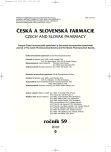A study of the process of homogenization of powder mixtures using NIR spectroscopy
Authors:
P. Doležel 1; J. Muselík 1; K. Dvořáčková 1; K. Šustová 2
Authors place of work:
Veterinární a farmaceutická univerzita Brno, Farmaceutická fakulta, Ústav technologie léků
1; Mendelova univerzita v Brně, Agronomická fakulta, Ústav technologie potravin
2
Published in the journal:
Čes. slov. Farm., 2010; 59, 263-271
Category:
Původní práce
Summary
The paper focuses on the use of NIR spectroscopy in the study of mixing powder mixtures. The study made use of model mixtures composed of diclofenac sodium salt, cetyl alcohol, povidon-30, sucrose and magnesium stearate. The measurement of NIR spectra was carried out with the use of a probe making it possible to scan the spectra direct from the homogenization vessel. The measured spectra were mathematically adjusted and subsequently processed by means of chemometric methods in order to obtain the predicate data on the course of mixing. The obtained data were evaluated by means of statistical methods and subsequently they were plotted into graphs in dependence on the time of mixing in order that the course of mixing could be well observable. The resulting graphs describing the course of mixing clearly show the stages of convective and diffuse mixing. The spectra which were statistically evaluated as remote were further studied in order to identify the causes of their origin. The other measurements included the data of physical properties of powders, namely flow density, Hausner ratio, and average particle size. The obtained data well illustrate the possibilities of NIR spectroscopy in the examination of the variability of the mixing process in time and document the suitability of NIR spectroscopy in the control of the process of mixing of powder mixtures.
Key words:
NIR spectroscopy – homogenization – convective mixing – diffuse mixing – chemometric methods
Zdroje
1. Brittain, H. G.: Spectroscopy of Pharmaceutical Solids. New York: Taylor & Francis Group 2006; 314–317.
2. Roggo, Y., Chalus, P., Maurer, L., Lema-Martinez, C., Edmond, A., Jent, N.: A review of near infrared spectroscopy and chemometrics in pharmaceutical technologies. J. Pharmaceut. Biomed. Anal., 2007; 44, 683–700.
3. Gauglitz, G., Vo-Dinh, T.: Handbook of Spectroscopy. Weinheim: Wiley-VCH, 2003; 105.
4. Berman, J., linski, D. E., onzales, C. R., ofer, J. D., imenez, P. J., lanchard, J. A., Tlachac, R. J.: Blend uniformity analysis: validation and in-process testing. Technical Report No. 25. PDA, PDA J. Pharm. Sci. Technol., 1997; 51, 1–99.
5. Dvořáčková, K., Rabišková, M., Masteiková, R., Okáčová, L.: Vliv koncentrace lipofilního nosiče na vlastnosti hydrofilně–lipofilních matricových systémů. Čes. slov. Farm., 2008; 57, 269–274.
6. Paul, E., Atiemo-Obeng, V., Kresta, S.: Handbook of Industrial Mixing. Hoboken: Wiley-interscience 2004; 887–982.
7. Siesler, H. W., Ozaki, Y., Kawata, S., Heise, H. M.: Near-Infrared Spectroscopy, Weinheim: Wiley-VCH 2002; 125–162.
8. Crowder, T. M., Hickey, A. J., Louey, M. D., Orr N.: A Guide to Pharmaceutical Particulate Science. New York: Interpharm/CRC, 2003; 75–79.
9. Masuda, H., Higashitani, K., Yoshida, H.: Powder Technology Handbook, 3. edition. New York: Taylor & Francis Group 2006; 371–382.
Štítky
Farmacie FarmakologieČlánek vyšel v časopise
Česká a slovenská farmacie

2010 Číslo 6
- Ukažte mi, jak kašlete, a já vám řeknu, co vám je
- Může slepičí polévka opravdu přispívat k uzdravení? Babiččin všelék z pohledu moderní vědy
- Mikroplasty a jejich riziko pro zdraví: Co všechno víme?
Nejčtenější v tomto čísle
- Orálně dispergovatelné lékové formy a technologie jejich výroby
- Studium procesu homogenizace práškových směsí s využitím NIR spektroskopie
- K dějinám lékárny Milosrdných bratří ve Skalici do roku 1919
- Používání humánních hromadně vyráběných léčivých přípravků ve veterinární praxi v České republice
